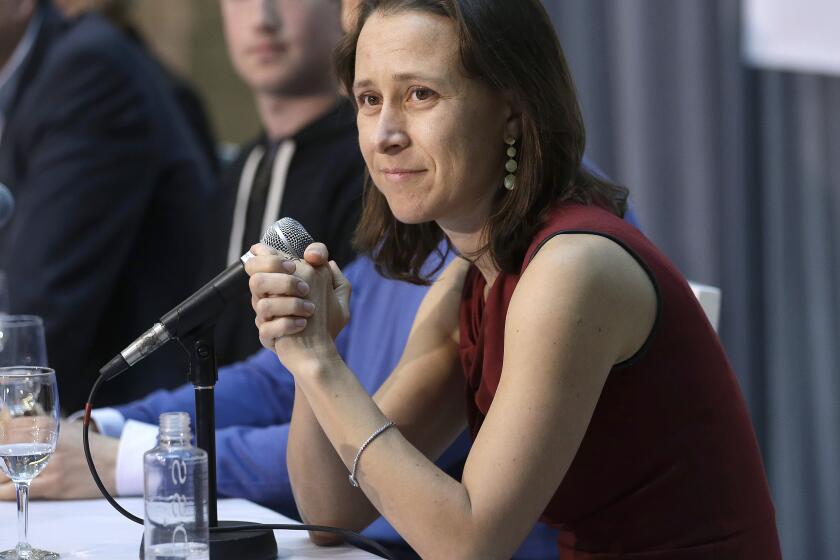Tragedy to Triumph : Helping Save Infants Became His Life Work
- Share via
ATLANTA — The sudden death of Pete Petit’s infant son 18 years ago changed his life and saved untold others. The grief-stricken engineer has built a multimillion-dollar corporation dedicated to giving infants a greater chance at survival.
Driven by grief and armed only with a drawing of a revolutionary product, the aerospace engineer left a high-paying job at Lockheed-Georgia to start a health-care company following the death of his 6-month-old son, a victim of sudden infant death syndrome, in 1970.
When he founded Healthdyne Inc. a year later, Parker Holmes Petit wanted only to develop a home-use infant monitor that would track breathing and heart rates and sound an alarm if breathing stopped or the heart rate fell below a certain level.
Six years later, Petit, Healthdyne’s chief executive, had accomplished his goal and was on his way to turning the company into a $90-million health-care concern dedicated to high-technology home-care services and therapies.
“Initially, I was very much motivated by grief,” Petit said. “It gave me something to put my time and effort and talents into and helped us get through that period of intense focus on the event.
“My initial focus was to develop a device that would prevent the same kind of thing from happening to other families that happened to our family.
“I didn’t need much more of a goal than that,” he said. “I didn’t think about building a large corporation or building a multifaceted international company because I didn’t have the vision then.”
What Petit had was a devotion to children that enabled him to sustain the business through hard times, including near bankruptcy, takeover attempts and a string of quarterly losses.
Petit’s affection for children comes across in the way he refers to them as “kiddos” and “little guys” and in the way he talks about the products his company makes to help infants.
Killer Disease
It’s more obvious when Petit reminisces about the summer evening his son, Brett, died.
Until Brett died of SIDS in June, 1970, Petit had never heard of the disease that kills between 8,000 and 10,000 American infants each year.
Petit was not alone in his ignorance.
It had been only two years before Brett’s death that a group of international physicians issued a medical treatise defining crib death as SIDS and identifying it as the leading killer of children under age 1.
The idea for the infant monitoring device came to Petit on a long drive through the north Georgia mountains that he took with his family after Brett’s funeral.
When he returned home, Petit, who holds a master’s degree in mechanical engineering from Georgia Tech, drew a rough sketch of the monitor he had in mind and brought it to Brett’s pediatrician, Scott James.
“He was very committed,” said James, a member of Healthdyne’s board. He also serves as the company’s medical director.
“Rather than go off and be mad at the world when his son died, he started thinking what he could do as an engineer to help other parents,” James said. “He turned grief into something very positive for mankind.”
Despite support from James and another medical researcher, Alfred Steinschneider, it took seven years before the American Academy of Pediatricians decided that home monitoring of infants suffering from apnea was an appropriate alternative to hospitalization.
Since 1977, Healthdyne has sold about 70,000 of Petit’s monitors--and saved thousands of young lives, if the letters, poems and cassette recordings received by the company are any indication.
“We’ve certainly had an impact on those infants,” he said. “They might not all have succumbed to SIDS, but the monitor has played a role in perhaps keeping them from having some severe apnea episodes that would have caused maybe brain damage and some subsequent health-care problems.”
While his home monitor was saving lives, Petit began to focus attention on getting doctors involved in SIDS research and obtaining the money to fund the projects.
Entered New Area
He founded the American SIDS Institute, based in Sandy Springs, Ga., an Atlanta suburb, in 1983 to conduct research and was instrumental in the establishment this year of SIDS Alliance, an umbrella organization in Baltimore that handles fund-raising for the six major SIDS research groups in the United States.
While still worried about the threat of SIDS, Petit recently moved Healthdyne into another unchartered area relating to infant mortality--premature birth.
As much as 15% of all pregnant women are diagnosed at risk of premature labor and about 200,000 infants are born prematurely--before 37 weeks in the 40-week pregnancy cycle--each year, Petit said, adding costs from these births total $5 billion annually, or about $25,000 a child.
Last year, Healthdyne began marketing a prenatal home monitoring program that allows doctors to monitor a woman’s uterine contractions to determine whether she is beginning labor.
“Every day we can extend that pregnancy, it saves $1,000 or $2,000 a day,” Petit said. “If you can extend a pregnancy one day, you generally cut down a day’s stay in a neonatal unit. So we’re saving the health-care industry money, plus babies are healthier.”
Even though Healthdyne’s home pregnancy monitoring program is being administered under an investigational permit from the Food and Drug Administration, obstetricians have prescribed it for about 2,000 women so far, Petit said.
Once the program is prescribed, a woman uses the equipment twice a day, strapping around her abdomen a belt that monitors uterine contractions. The data is transferred via telephone to 25 Healthdyne centers around the country, where a nurse evaluates the information for the patient’s doctor.
Fees for the monitoring program run up to $90 a day, and Healthdyne has control of about 25% of the market for the monitors, said Petit, who is counting on sales of the service and new products to eventually reverse several years of financial losses.
After logging a profit of $5.3 million in 1983, Healthdyne lost $35.2 million in 1984, $21.3 million in 1986 and $5.5 million in 1987. Sandwiched between the losses were modest earnings of $938,000 in 1985.
Start-up costs associated with the pregnancy monitoring program contributed significantly to the $2.8 million lost by Healthdyne in the first nine months of 1988, and the company recently took steps to remedy its financial health.
Healthdyne launched a restructuring program Oct. 31 in which the company’s lucrative infusion therapy and home-care products branches were kept under the Healthdyne name.
The company’s pregnancy monitoring or perinatal group and the home-care services division--which rents durable equipment to bed-ridden patients--were spun off into a separate entity.
Petit blames much of the company’s earlier financial problems on government changes in reimbursement policies, which caused an industrywide downturn in home health-care services.
But with the home health-care market expected to expand to $12 billion by 1990 from $8 billion last year, Petit predicts that a healthier Healthdyne will emerge.
More to Read
Inside the business of entertainment
The Wide Shot brings you news, analysis and insights on everything from streaming wars to production — and what it all means for the future.
You may occasionally receive promotional content from the Los Angeles Times.








